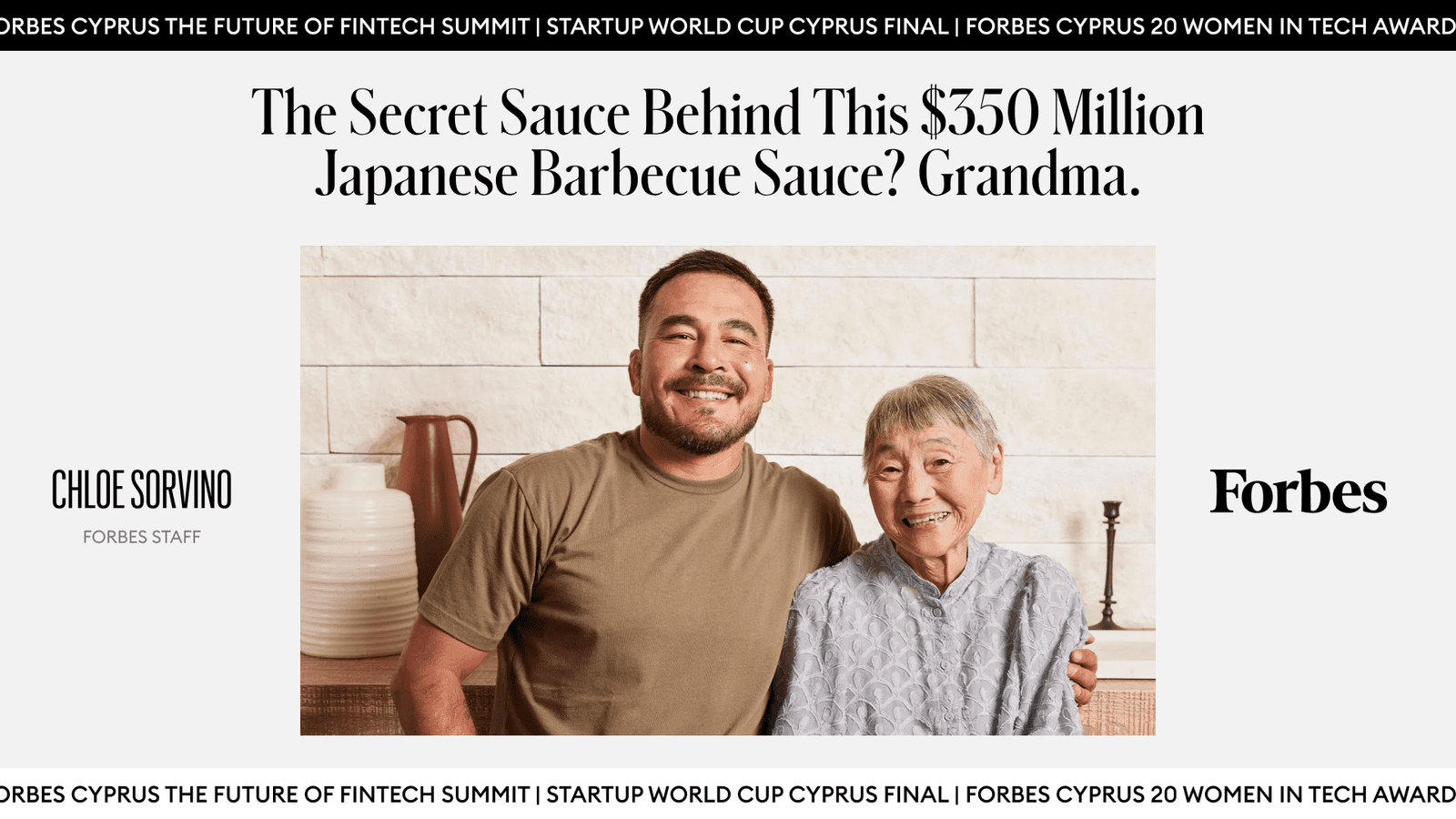From a headquarters nestled between vineyards in Sonoma County, California, pounds of ginger, rice vinegar, mirin and sesame oil are sent to be mixed into large vats of what will soon become Bachan’s Japanese barbecue sauce. The various flavors will then be piped into its signature plastic squeeze bottles. Justin Gill, Bachan’s 43-year-old founder and CEO, points out that, he was first to use the now-trendy packaging that’s ubiquitous on grocery store shelves.
“I wanted to build a brand that was approachable and accessible,” says Gill, “One that would work just as well at Whole Foods as it would in Walmart.”
Follow THE FUTURE on LinkedIn, Facebook, Instagram, X and Telegram
The mass appeal of Bachan’s is one of many reasons why Gill’s sweet and savory sauce started to stick soon after he launched the brand in 2019. A beloved family recipe is another. Bachan’s, named after the Japanese American term for granny, originated from a sauce his own grandmother-made for decades. Bachan’s is now the top-selling barbecue sauce at both Amazon and Whole Foods, and the fastest-growing condiment brand in the country. With estimated annual revenue topping $70 million, Bachan’s is having the kind of moment that made Sriracha founder David Tran a billionaire.
Bachan’s is profitable, too, and Forbes estimates operating margins are as much as 20% annually. Gill declined to comment on the revenue or profitability of his private business. At a conservative 5 times multiple, Bachan’s could be worth more than $350 million, and his company could get acquired for a lot more. Spice, after all, sells. In 2020, McCormick spent $800 million buy Cholula hot sauce—in a deal valued at 10 times revenue. Other recent deals for bold-flavored condiment brands have sold for as high as 8 times.
“I bootstrapped for so long and took so much personal financial risk to be able to control my business and then become profitable,” Gill says. He has held onto the majority ownership, even after raising $17 million from investors over two rounds and making sure that all of Bachan’s employees, from the warehouse to the headquarters, own their own shares. Gill credits his control with fighting for the right terms when dealmaking, instead of going for bigger valuations. He says he has no plans to raise more in the short-term, adding that the company is “totally self-sustainable.”
“At a certain point, you kind of just have to take the risk,” says Gill. “But A key part of our success has been our strategy of being very disciplined.”
Gill’s entrepreneurial journey starts with his own bachan, Judy Yokoyama. A first-generation Japanese American who spent two years as a child at a Japanese internment camp in the Colorado desert called Camp Amache, Yokoyama lived with Gill’s family while he grew up in Sebastopol, California, and he remembers her consistently brewing large batches of the heirloom recipe. Throughout Gill’s childhood in Sonoma County, Yokoyama made some anytime there was a big gathering or holiday. At Christmastime, the sauce was gifted to clients of the family’s landscape design business. Handing out bottles door-to-door with the rest of his family left an impression on Gill, who loved when recipients would show off empty bottles from the previous year.
Gill cherished his grandmother’s secret recipe, and, in 2013, after years of working with his family in landscape design, he decided to bring the sauce to the masses. “I wanted to do something I love,” Gill recalls, “and really wanted to show my daughters what’s possible in life if you chase your dream and just give everything you have to it.”
It took six years of testing out different formulations at different plants in California before Gill was satisfied. Mass-produced condiments get made at scale thanks to preservatives and pasteurizing, but that ruined the taste and texture of the sauce Gill remembered from his childhood. Gill, who studied chemistry and horticulture plant science at California Polytechnic State University-San Luis Obispo, eventually figured out how to engineer a process to cold-fill the sauce into its bottles, negating the need to pasteurize.
“I really saw that all condiments are made in [the same] manner, so, if I could make mine taste like our home recipe, we’d have something totally different,” says Gill. “And if I could do it without any preservatives or a bunch of oils, then I would have something that would be an amazing product and truly represent my family.”
The 10 ingredients Bachan’s uses today are minimally processed and high-quality—certainly more premium than what Gill’s middle-class family originally used, he says. Take one of the key ingredients, mirin. The type of mirin Bachan’s sources has been made by the same family in Japan for seven generations.
After Bachan’s launched in 2019, Gill took it upon himself to hawk the sauce himself. He gave out samples at stores every weekend in that first year—from natural food stores around Northern California to specialty stores near the headquarters in Sebastopol. When the pandemic hit, the home he shares with his wife and three young daughters became Bachan’s fulfillment center.

BACHAN’S
As Bachan’s began earning revenue, Gill reinvested it back into Facebook ads, and took out loans to pour in even more. It was a grueling cycle: 50% of daily revenue went back to paying high-interest loans.
Committed to bootstrapping, Gill took on two personal loans from friends—one for $100,000 was tied to his home—but he couldn’t get a small business loan so he maxed out credit cards.
Then he invested the money into more social media ads and bigger production runs. The boost worked, and Bachan’s quickly rose to become the top-selling barbecue sauce on Amazon.
Out of the gates, grocery store buyers tried to relegate Bachan’s—to the global flavors aisle, which was then referred to as the “ethnic” aisle. Gill fought to compete on shelves next to other barbecue sauce brands, where there’s typically more foot traffic in stores, and the bet paid off. Spins, which tracks sales at grocers, estimates the barbeque sauce market at $1 billion, as a rise in regionality has gained traction among shoppers.
Whole Foods was willing to try it out, and Bachan’s launched in 60 stores, where Bachan’s became the top seller in the grocer’s barbecue sauce aisle. “It can be challenging for brands to penetrate sauce and barbecue sauce. It’s really regionally driven,” says Whole Foods’ Lizette Coello, who manages global flavors and condiment buying. “What’s exciting about Bachan’s is they really re-energize this category that’s deeply rooted in American tradition with all the things you want in a good sauce—but in a totally different way.”
In 2021, Gill raised Bachan’s first round of capital, after an investor at Prelude Growth Partners realized the company had no institutional backers, yet it had maintained its position as Amazon’s No. 1 selling barbecue sauce. Prelude bought a minority stake for $4 million.
“It was the smallest brand at the time of our investment that we’ve invested in across all of our businesses,” says Neda Daneshzadeh, Prelude’s managing partner and cofounder. “But it was because we had such conviction in him as a founder and in the brand.”
It was Gill’s first big moment of relief: a large sum of cash in the bank. By the time Bachan’s went back to investors in 2022, the company had become profitable, and that put Gill at a position of strength. His second round, led by Sonoma Brands, closed at $13 million. What drew in Sonoma to the brand was customers’ reactions to Bachan’s, which Sonoma’s founder Jon Sebastiani says has been “just mind-blowing to me as an investor.”
“It’s a Sriracha 2.0,” Sebastiani says of the hot sauce that made David Tran a billionaire. “Sriracha took the world by storm and is this phenomenal condiment that’s just become ubiquitous with Asian cuisine and used on non-Asian food. I see Bachan’s in the same way.”
That vote of confidence helped Gill take his biggest leap yet: launching into Walmart. Gill had backed off when America’s largest retailer expressed interest several years earlier, but once he decided that Bachan’s was ready for Walmart, it became an instant hit.
Bachan’s even got mentioned by Walmart’s U.S. CEO John Furner during an earnings call in May 2023, which rarely happens for food brands. Furner used Bachan’s as an example of how he’s “personally encouraged by the way the merchants are looking at new ways to find new items, bring those to life, and drive sales all across the country.”
Bachan’s has “set fire in the marketplace and inspired other companies to create their own versions of the sauce,” adds Damon Keith, Walmart’s U.S. director of merchandising for sauces and condiments, who adds that Bachan’s has “performed very well and grown share.” After launching in 3,000 stores last year, 1,000 more got added this year.
Now that Bachan’s is sold in 25,000 stores nationwide, Gill says he’s hyper-focused on reaching even more customers and “going deeper” in the category. As awareness of Bachan’s increases, Gill then wants to continue to build by moving into adjacent products, like dipping sauces.
“We want to be the first iconic Japanese American food, and when I say iconic, I mean we want to be Heinz ketchup and Tabasco hot sauce,” says Gill. “I want to be ubiquitous in American culture. That allows us to also share our culture and my family legacy.”











